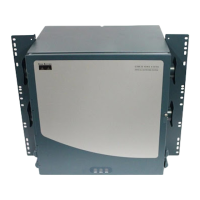6-49
Cisco ONS 15454 Procedure Guide, R5.0
August 2005
Chapter 6 Create Circuits and VT Tunnels
NTP-A314 Create a Unidirectional OC-N Circuit with Multiple Drops
Note For manually routed circuits, CTC checks your manually provisioned path against the path
diversity option you choose. If the path does not meet the path diversity requirement that is
specified, CTC displays an error message.
Step 14 If you selected Fully Protected Path in Step 12 and the circuit will be routed on a BLSR DRI or
path protection DRI, check the Dual Ring Interconnect check box.
Step 15 Click Next. In the Route Review/Edit area, node icons appear for you to route the circuit manually. If
you checked Dual Ring Interconnect for BLSR, continue with Step 16. If you did not check Dual Ring
Interconnect, continue with Step 17.
a. Click a node or span on the circuit map.
b. Click Include to include the node or span in the circuit. Click Exclude to exclude the node or span
from the circuit. The order in which you choose included nodes and spans is the order in which the
circuit is routed. Click spans twice to change the circuit direction.
c. Repeat Steps a and b for each node or span you wish to include or exclude.
d. Review the circuit constraints. To change the circuit routing order, choose a node in the
Required Nodes/Lines or Excluded Nodes Links lists and click the Up or Down buttons to change
the circuit routing order. Click Remove to remove a node or span.
Step 16 If you checked Dual Ring Interconnect in Step 14 for a BLSR DRI, complete the following substeps to
assign primary and secondary nodes. Otherwise, continue with Step 17.
a. In the Route/Review Edit area, click the BLSR-DRI Nodes tab.
b. Click Add BLSR DRI.
c. In the Node Options area of the BLSR DRI Options dialog box, complete the following (for an
example of a traditional and integrated route on primary and secondary nodes, see Figure 6-11 on
page 6-42):
• Primary Node—For a traditional or integrated BLSR-DRI, choose the node where the circuit
interconnects the rings.
• Secondary Node—For a traditional or integrated BLSR-DRI, choose the secondary node for the
circuit to interconnect the rings. This route is used if the route on the primary node fails.
• Primary Node #2—For a traditional BLSR-DRI where two primary nodes are required to
interconnect rings, choose the second primary node.
• Secondary Node #2—For a traditional BLSR-DRI where two secondary nodes are required,
choose the second secondary node.
d. In the Ring and Path Options area, complete the following:
• The first ring is—Choose UPSR or BLSR from the drop-down list.
• The second ring is—Choose UPSR or BLSR from the drop-down list.
• Use ring interworking protection (RIP) on secondary path—Check this box to carry the
secondary spans on the protection channels. These spans will be preempted during a ring/span
switch.
e. Click OK.
f. Review the circuit constraints. To change the circuit routing order, choose a node in the
Required Nodes/Lines lists and click the Up or Down buttons to change the circuit routing order.
Click Remove to remove a node or span.
g. Click the Included Spans tab, and continue with Step 18.

